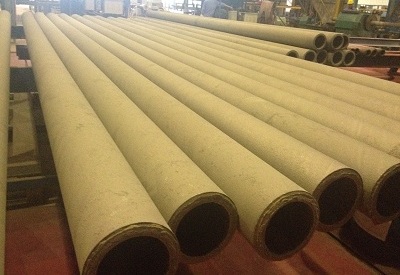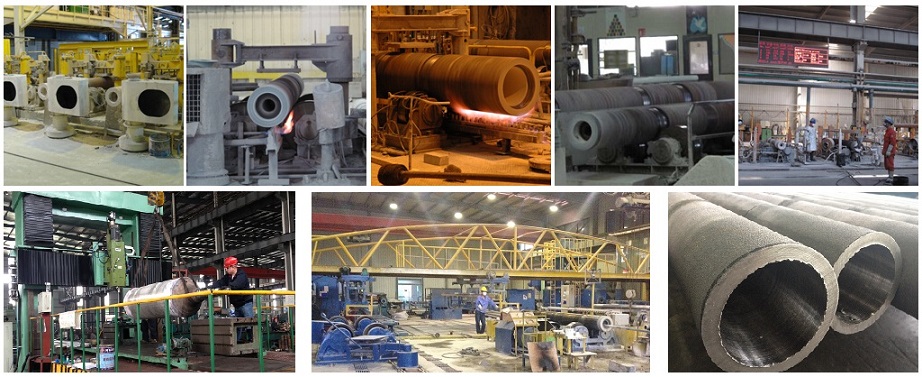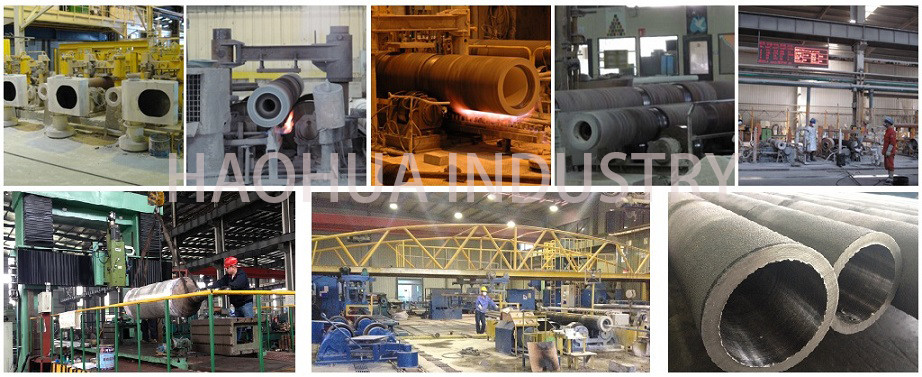




Horizontal centrifugal casting pipe
Centrifugal casting consists of a number of processes in which the centrifugal force set up by the rotation of a part of the casting installation is utilized to shape the casting, fill the mold, and help solidify and strengthen the metal. There is a difference between Vertical centrifugal casting and horizontal centrifugal casting. The first mentioned process is essentially a pressure-casting technique employing rotation about a vertical axis. It produces good filling of the mold, high dimensional accuracy, and a high strength dense structure of the casting metal. This method is used for casting of components that are too difficult to produce satisfactorily by static casting methods because their sections are too thin or for other reasons: e.g., gears, piston rings, impellers, propellers, bushings and railway wheels. Horizontal centrifugal casting is used mainly for making long hollow castings, such as pipes, gun barrels, sleeves, etc.

The mold rotates at high speed about a horizontal axis, the molten metal being fed into the interior of the mold and distributed around it by centrifugal action. Rotation is continued until solidification is complete. The external diameter of the casting corresponds to the internal diameter of the mold. The internal diameter of the casting can, however, be varied by appropriately proportioning the amount and feed rate of the casting metal. An advantage of the centrifugal process is that it produces a sounder and more uniform casting than static means. The mold is usually made of steel or cast iron. Non-metallic linings may be used.
The molten iron is introduced into the mold through a long duct from a tilting ladle containing the correct amount of casting metal to form the pipe. When the mold has reached a certain speed of rotation, the molten iron is admitted to it, and mold is moved slowly forwards while the feed duct remains stationary, so that uniform distribution of the metal along the mold is achieved. Moore’s method uses a rotating mold with a sand lining, which protects the metal shell of the mold so that water cooling is not necessary. The sand itself is applied to the mold wall and compacted by centrifugal action. The inlet duct is short because, with a sand lining, solidification of the casting takes a relatively long time (no rapid cooling); proper filling of the mold is thus ensured. This process has the advantage of not requiring a wide range of molds of different diameters, since any desired pipe diameter can be produced simply by varying the thickness of the sand lining.
Centrifugal methods are also used for the production of composite castings. Centrifugal casting as are categorized into Centrifugal Casting, Semi-Centrifugal Casting and Centrifuging. In centrifugal casting, a permanent mold is rotated about its axis at high speeds (300 to 3000 rpm) as the molten metal is poured. The molten metal is centrifugally thrown towards the inside mold wall, where it solidifies after cooling. The casting is usually a fine grain casting with a very fine-grained outer diameter, which is resistant to atmospheric corrosion, a typical situation with pipes. The inside diameter has more impurities and inclusions, which can be machined away. Only cylindrical shapes can be produced with this process. Size limits are upto 3 m (10 feet) diameter and 15 m (50 feet) length. Wall thickness can be 2.5 mm to 125 mm (0.1 - 5.0 in). The tolerances that can be held on the outer diameter can be as good as 2.5 mm (0.1 in) and on the ID can be 3.8 mm (0.15 in). The surface finish ranges from 2.5 mm to 12.5 mm (0.1 - 0.5 in) rms. Typical materials that can be cast with this process are iron, steel, stainless steels, and alloys of aluminum, copper and nickel.
Two materials can be cast by introducing a second material during the process. Typical parts made by this process are pipes, boilers, pressure vessels, flywheels, cylinder liners and other parts that are axi-symmetric. In Semi-Centrifugal Casting, the molds used can be permanent or expendable, can be stacked as necessary. The rotational speeds are lower than those used in centrifugal casting. The center axis of the part has inclusion defects as well as porosity and thus is suitable only for parts where this can be machined away. This process is used for making wheels, nozzles and similar parts where the axis of the part is removed by subsequent machining. Centrifuging is used for forcing metal from a central axis of the equipment into individual mold cavities that are placed on the circumference. This provides a means of increasing the filling pressure within each mold and allows for reproduction of intricate details. This method is often used for the pouring of investment casting pattern.